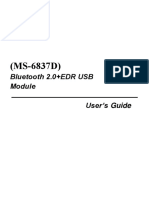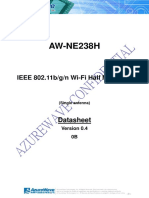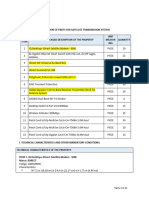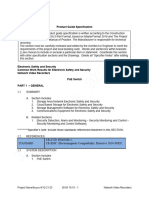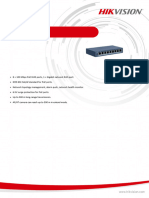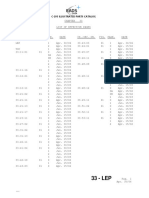GWF-7M02 Spec V1.0
GWF-7M02 Spec V1.0
Uploaded by
AlexCopyright:
Available Formats
GWF-7M02 Spec V1.0
GWF-7M02 Spec V1.0
Uploaded by
AlexOriginal Title
Copyright
Available Formats
Share this document
Did you find this document useful?
Is this content inappropriate?
Copyright:
Available Formats
GWF-7M02 Spec V1.0
GWF-7M02 Spec V1.0
Uploaded by
AlexCopyright:
Available Formats
150Mbps
IEEE 802.11 b/g/n WiFi Module
Product Specifications
Model: GWF-7M02
Version: 1.0(Draft)
2013-04-09
Information in this document is subject to change without prior notice. Page 1 of 10
1. Introduction
The GWF-7M02 is a WLAN PCB module with 7-pin connector supporting USB2.0 interface, it supports
IEEE 802.11b/g/n standards. This module operates in 2.4GHz ISM frequency band with low power
consumption; it applies a highly integrated MAC/BBP and RF single chip MT7601U with 150Mbps PHY rate
supporting.
The small form factor and low cost design provide excellent performance for the wireless connectivity, it is
ideal for confine space application.
2. Features
z 20MHz/40MHz bandwidth support. 1T1R mode
z 802.11b: 1, 2, 5.5, 11Mbps; 802.11g: 6, 9, 12, 24, 36, 48, 54Mbps ;
z 802.11n: Support PHY rate up to 150Mbps.
z Security support for WEP 64/128, WPA,WPA2, TKIP,AES
3. Application
z Portable Smart Device: Mobile, Tablet, Mini-PC, etc.
z Others: TV, Meida player, Setup box, IP cam, Camcorder etc.
4. Product Description
4.1. Block Diagram
Figure 1 With external antenna used
Information in this document is subject to change without prior notice. Page 2 of 10
Figure 2 With onboard PCB antenna used
4.2. Specification:
General
Main Chipset MediaTek MT7601U
Device Interface USB 2.0, 7 PCB Semi-holes
RF output External antenna Via I-PEX MHF receptacle or Built-in On Board
Dimensions 28x14mm
Weight 1.75g
WLAN
Operation Frequency 2412~2483.5MHz, ISM band (Depends on country region)
Operation Channel Ch1~14 (Depends on country region)
Protocol 802.11b: CCK, QPSK, BPSK, 802.11g/n: OFDM
Security 64/128 WEP, WPA/WPA2, WFA, WPS2.0, WAPI
QoS: WFA,WMM,WMM PS;
Others
WiFi Direct
RF Characteristics (Typical)
Antenna External antenna Via I-PEX MHF receptacle
802.11b (CCK) 11Mbps: 18+/-1dBm
802.11g (OFDM) 54Mbps: 16+/-1dBm
Transmit Power
802.11n (HT20@MCS7), 14+/-1dBm
802.11n (HT40@MCS7),14+/-1dBm
Receive Sensitivity 802.11b: -88+/-1dBm;802.11g: -72+/-1dBm
Information in this document is subject to change without prior notice. Page 3 of 10
802.11n (HT20), -70+/-1dBm; 802.11n (HT40), -68+/-1dBm
DC Characteristic (Typical)
Operating Voltage 3.3V or 5.0V DC +/-5%
Normal operation (Average) <80mA
Sleep mode 1.5 mA
Current consumption TX HT40,MCS7@16dBm 210 mA
TX CCK 250 mA
RX Listen 6 mA
4.3. Mechanical Information
4.3.1. OUTLINE (Pictures are for reference only)
4.3.2. Dimensions and Pinout:
A. Semi-holes with 2.0mm pitch (external RF antenna via I-PEX MHF receptacle)
I-PEX
receptacle
Information in this document is subject to change without prior notice. Page 4 of 10
B. Semi-holes with 2.0mm pitch (onboard PCB antenna).
C. Top side 7-pin pin header with 2.0mm pitch
Information in this document is subject to change without prior notice. Page 5 of 10
D. Bottom side 7-pin pin header with 2.0mm pitch
E. 90 degree 7-pin pin header with 2.0mm pitch
Information in this document is subject to change without prior notice. Page 6 of 10
4.3.3. Pin Definition:
Pin Name Description
1 TX RF ON/OFF control; low level activated to OFF
2 VCC 5.0VDC or 3.3VDC, +/-5%
3 UD- USB data-
4 UD+ USB data+
5 GND Ground
6 LED Indicate module working status
External to activate WPS function. Low level
7 WPS
activated
Notes:
1. TX terminal must be pulled up with an external resistor (4.7K ohm) to high level.
2. LED terminal output 3.3V LED blink signal. To limit LED current, a series 330 ohm or
other value resistor should be connected.
3. WPS terminal is internally pulled up with an onboard 4.7K ohm resistor to 3.3VDC.
4.4. Software and system Information
Operation System Driver
Linux 2.4/2.6 Draft
Android 4.1 ready
Windows XP/Vista/7/8 ready
Mac OS X 10.3~10.8 Not ready
5. Agency Approval
Agency Approval
FCC Part15 Not ready
CE Not ready
RoHS √
Information in this document is subject to change without prior notice. Page 7 of 10
6. Environment
6.1. Temperature
z Operating Temperature
Continuous reliable operation in ambient temperature: -10ºC to +60ºC.
z Storage Temperature
The product is not damaged or degraded when keeping in -20ºC to +85ºC.
6.2. Humidity
z Operating Humidity Conditions
The product should be capable of continuous reliable operation when subjected to relative
humidity in the range of 20% to 80% (non-condensing) .
z Non-Operating Humidity Conditions (including warehouse)
The product should not be damaged or degraded when kept in the place (where relative
humidity range is in the range of 20% to 80%) for 36 hours.
7. Design Concerns:
7.1. Power supply:
1) The input power can be 5.0VDC or 3.3VDC, please mentioned it when place an
order.
2) The operation current of 5.0VDC power input will be different with that of 3.3V power
input. The external power shall be well designed with enough capacity.
3) Should 3.3VDC power be selected, please be sure it’s clean with low ripple;
otherwise, the EMI or RF performance might be deteriorated.
7.2. Using pin headers:
1) The pins can be less than 7 pins, but the VCC, UD-, UD+, GND must be applied for
USB interface communication.
2) Should the pin header connection be applied, please still keep enough metallic clear
space around the antenna end of the module, this gives better antenna performance
7.3. Using semi-holes:
1) When the module is designed to be soldered on a main PCB board directly, the area
Information in this document is subject to change without prior notice. Page 8 of 10
under the antenna end of the module should be keep clear of metallic components,
connectors, vias, traces and other materials that can interfere with the radio signal.
2) The module is not recommended using reflow oven process, hand soldering is
suggested.
7.4. Footprint design reference:
The following drawing shows a recommended footprint which can be a reference design for a main
PCB layout.
7.5. Soldering requirement:
The module is not recommended using reflow oven process, hand soldering is suggested.
Information in this document is subject to change without prior notice. Page 9 of 10
If reflow oven process is selected, please keep good control on the soldering process. Otherwise
the flow air might blow components removing. A reference flow chaw likes as following:
Notes: user should adjust setting of reflow oven to get best soldering quality
8. Disclaimer
THESE MATERIALS AND INFORMATION ARE PROVIDED “AS IS” WITHOUT WARRANTY OF ANY
KIND, EITHER EXPRESS OR IMPLIED , INCLUDING BUT NOT LIMITED TO, THE IMPLIED
WARRANTIES OF MERCHANTABILITY, FITNESS FOR A PARTICULAR PURPOSE OR
NON-INFRINGEMENT.
We uses reasonable efforts to include accurate and up-to-date information on this document; it does not,
however, make any representations as to its accuracy or completeness of the information, text, graphics,
links or other items contained within these materials. Your use of this Document is at your own risk. Ogemray,
its suppliers, and other parties involved in creating and delivering this Document’s contents shall not be liable
for any special, indirect, incidental, or consequential damages, including without limitation, lost revenues or
lost profits.
Information in this document is subject to change without prior notice. Page 10 of 10
You might also like
- Calculation of Runway Field Length - ATR AircraftsDocument5 pagesCalculation of Runway Field Length - ATR AircraftsCoochbehar Aai100% (9)
- XK-F301E User ManualDocument17 pagesXK-F301E User ManualEvgeniiNo ratings yet
- Technical Specification: 40' X 8' X 8'6" ISO 1AA TYPE Steel Dry Cargo ContainerDocument23 pagesTechnical Specification: 40' X 8' X 8'6" ISO 1AA TYPE Steel Dry Cargo ContainerMAYMODERN STEELNo ratings yet
- HJ RF Module: Spec V1.0Document9 pagesHJ RF Module: Spec V1.0Khalil AwawdaNo ratings yet
- XK-F311E Video Data Links (500MW) 20191120Document7 pagesXK-F311E Video Data Links (500MW) 20191120ᜆ᜔ᜀᜄ᜔ᜀ ᜉ᜔ᜀᜄ᜔ᜉ᜔ᜀᜎ᜔ᜀᜌ᜔ᜀNo ratings yet
- F23BDSM25 W1Document11 pagesF23BDSM25 W1Nathalis CortexNo ratings yet
- E28-2G4M12S Datasheet EN v1.1Document7 pagesE28-2G4M12S Datasheet EN v1.1HenriqueNo ratings yet
- NDS3306I 6 in 1 ISDB-T Modulator User Manual 2018.11.26Document24 pagesNDS3306I 6 in 1 ISDB-T Modulator User Manual 2018.11.26jhunniorNo ratings yet
- User Manual Rev 1 3988661Document5 pagesUser Manual Rev 1 3988661มาหะมะNo ratings yet
- Chinowing V21 User ManualDocument29 pagesChinowing V21 User ManualEvgeniiNo ratings yet
- Users Manual 4666270Document10 pagesUsers Manual 4666270Ano InkNo ratings yet
- RL Um12bs 8188eus WifiDocument9 pagesRL Um12bs 8188eus WifiRosyim ArifiyantoNo ratings yet
- WMPCIE V01 (7F900 AWGE780 RS) Manual SPECDocument6 pagesWMPCIE V01 (7F900 AWGE780 RS) Manual SPECFischer Escalante AldoNo ratings yet
- Manual WN8122E1Document11 pagesManual WN8122E1Samuel Ulises Leon GonzalezNo ratings yet
- FSD-800/FSD-801 User ManualDocument22 pagesFSD-800/FSD-801 User ManualWendelin BudilNo ratings yet
- 5 GHZ Airmax Ac Cpe With Wi-Fi Management RadioDocument24 pages5 GHZ Airmax Ac Cpe With Wi-Fi Management RadioMindSet MarcosNo ratings yet
- Users Manual 960765Document90 pagesUsers Manual 960765igorNo ratings yet
- Xethru-Novelda X2M300 - Presence - Module - Datasheet - PreliminaryDocument10 pagesXethru-Novelda X2M300 - Presence - Module - Datasheet - Preliminaryyura yuraNo ratings yet
- Esp32 Wrover B Datasheet en 1384674Document28 pagesEsp32 Wrover B Datasheet en 1384674George BintarchasNo ratings yet
- AzureWave AWNE238h WiFi CardDocument15 pagesAzureWave AWNE238h WiFi CardHussain Amir Ali75% (4)
- DS RF TTL 100 V01 enDocument16 pagesDS RF TTL 100 V01 enHùngNo ratings yet
- WG203 2.4/5G 2X2 MIMO WLAN Module DatasheetDocument8 pagesWG203 2.4/5G 2X2 MIMO WLAN Module DatasheetDaryl DixonNo ratings yet
- Specification: RL-SM02BD (Realtek RTL8723BS) Combo ModuleDocument14 pagesSpecification: RL-SM02BD (Realtek RTL8723BS) Combo ModuleRebiai BachaNo ratings yet
- UF Nano QSGDocument24 pagesUF Nano QSGravanod550No ratings yet
- Fiber Optic Ieee c37.94 g.703 E1 Multiplexer pdf2 133 PDFDocument18 pagesFiber Optic Ieee c37.94 g.703 E1 Multiplexer pdf2 133 PDFxvehicleNo ratings yet
- XK-F304E User ManualDocument15 pagesXK-F304E User ManualdanitoNo ratings yet
- V31 Series Video&Amp Data&Amp RC Link User ManualDocument29 pagesV31 Series Video&Amp Data&Amp RC Link User ManualJoseph ThomasNo ratings yet
- WIFI-2-M06USA1: WLAN 802.11b/g/n ModuleDocument4 pagesWIFI-2-M06USA1: WLAN 802.11b/g/n Modulemben osbiNo ratings yet
- SCIENCEDocument7 pagesSCIENCEFidele KouakouNo ratings yet
- ESP32-wrover Datasheet enDocument27 pagesESP32-wrover Datasheet enSection Maintenance LP-BlériotNo ratings yet
- ESP-M1: Product SpecificationDocument16 pagesESP-M1: Product SpecificationansifaNo ratings yet
- Wifi RTL8189ETVDocument9 pagesWifi RTL8189ETVHai YenNo ratings yet
- Lm823 Wifi 802.11 B/G/N Module With Ipex Receptical: Host Controller Interface (Hci) Via Usb InterfaceDocument12 pagesLm823 Wifi 802.11 B/G/N Module With Ipex Receptical: Host Controller Interface (Hci) Via Usb InterfaceFelipe SoffiattiNo ratings yet
- 201508181629102776Document7 pages201508181629102776Daryl DixonNo ratings yet
- RN-171 802.11 B/G Wireless LANDocument16 pagesRN-171 802.11 B/G Wireless LANAnonymous 60esBJZIjNo ratings yet
- Req Redes01Document10 pagesReq Redes01americo.tritecNo ratings yet
- JZ881 User's ManualDocument6 pagesJZ881 User's Manualhasanahiswatun402No ratings yet
- Aw GM320 PDFDocument10 pagesAw GM320 PDFhadiNo ratings yet
- TYSW-012 Round Universal Remote Control - Tuya Smart - DocumentationDocument12 pagesTYSW-012 Round Universal Remote Control - Tuya Smart - Documentationmudhiraj ROHITKUMARNo ratings yet
- Neoway - M660 Hardware Design Guide V1.2Document28 pagesNeoway - M660 Hardware Design Guide V1.2Simmhadri SimmiNo ratings yet
- Object 181024Document10 pagesObject 181024americo.tritecNo ratings yet
- Baicells Neutrino-224 Indoor LTE FDD Base Station Specification-V1.1Document8 pagesBaicells Neutrino-224 Indoor LTE FDD Base Station Specification-V1.1Lo GamNo ratings yet
- Datasheet - Bluetooth & Zigbee Module Spec - 20190423Document11 pagesDatasheet - Bluetooth & Zigbee Module Spec - 20190423sarath gaddamNo ratings yet
- ZBT WG1602 SpecificationDocument10 pagesZBT WG1602 SpecificationNandoNo ratings yet
- Users Manual 2506260Document11 pagesUsers Manual 2506260Nakama Sombrero de PajaNo ratings yet
- Product Guide SpecificationDocument6 pagesProduct Guide SpecificationRexinNo ratings yet
- Esp32 Wroom 32dDocument24 pagesEsp32 Wroom 32dRazwan ali saeedNo ratings yet
- WCB735M - Technical Spec & ManualDocument10 pagesWCB735M - Technical Spec & ManualOscar castroNo ratings yet
- Отправка По Электронной Почте XK-F303E User ManualDocument16 pagesОтправка По Электронной Почте XK-F303E User ManualEvgeniiNo ratings yet
- AW-NB110H WiFi Chipset Awnb110h0b - v.1.0 - StandardDocument13 pagesAW-NB110H WiFi Chipset Awnb110h0b - v.1.0 - StandardjfgohlkeNo ratings yet
- Ds-3E1309P-Ei/M 8-Port 10/100M PoeDocument4 pagesDs-3E1309P-Ei/M 8-Port 10/100M PoeRicardo MolinetNo ratings yet
- 12.1" Driver HMI With Intel Atom X5-E3930 Processor: FeaturesDocument3 pages12.1" Driver HMI With Intel Atom X5-E3930 Processor: FeaturesmohamedNo ratings yet
- ESP-WROOM-32D/ESP32-WROOM-32U Datasheet: Espressif SystemsDocument25 pagesESP-WROOM-32D/ESP32-WROOM-32U Datasheet: Espressif SystemsVictor Hernandez MedinaNo ratings yet
- Esp32 Wrover B Datasheet enDocument27 pagesEsp32 Wrover B Datasheet enMonse CabalNo ratings yet
- ESP-WROOM-32 Datasheet: Espressif SystemsDocument26 pagesESP-WROOM-32 Datasheet: Espressif SystemsChanchai SrisutamNo ratings yet
- LoRa1278F30 1W Wireless Tranceiver Module V3.1Document11 pagesLoRa1278F30 1W Wireless Tranceiver Module V3.1marcusNo ratings yet
- Esp32-Wroom-32se Datasheet enDocument26 pagesEsp32-Wroom-32se Datasheet enWesllen Dias SouzaNo ratings yet
- BT-PON BT-711XR XPON ONU ONT DatasheetDocument5 pagesBT-PON BT-711XR XPON ONU ONT Datasheetnayux ruizNo ratings yet
- B311-221 10.0.1.1 (H187SP60C983) Release NotesDocument8 pagesB311-221 10.0.1.1 (H187SP60C983) Release NotesAbdoNo ratings yet
- GW8000 Gateway (Rev1.0)Document7 pagesGW8000 Gateway (Rev1.0)Antoine A. SoyohNo ratings yet
- Connection-Oriented Networks: SONET/SDH, ATM, MPLS and Optical NetworksFrom EverandConnection-Oriented Networks: SONET/SDH, ATM, MPLS and Optical NetworksNo ratings yet
- Joie Ann ManalaysayDocument4 pagesJoie Ann ManalaysayJohn Errol MergalNo ratings yet
- Parliamentary System of IndiaDocument14 pagesParliamentary System of IndiaAmazing Aditi SingalNo ratings yet
- Marketing Planning and Implementation - P1WiMAXDocument40 pagesMarketing Planning and Implementation - P1WiMAXAzrul AzliNo ratings yet
- Actuator 3025 SeriesDocument40 pagesActuator 3025 SeriesNithya NatarajanNo ratings yet
- Soal Semester GanjilDocument8 pagesSoal Semester GanjilCindra PdanNo ratings yet
- Consti1 Outline ADBautista (1st Semester SY 2006 2007)Document16 pagesConsti1 Outline ADBautista (1st Semester SY 2006 2007)lex libertadore100% (1)
- Vocab For Hotel Review and PracticeDocument6 pagesVocab For Hotel Review and Practicefauziah halimNo ratings yet
- Hirarc FormatDocument1 pageHirarc FormatKerr AgotNo ratings yet
- Petrochina International Jabung LTD.: Job Safety AnalysisDocument8 pagesPetrochina International Jabung LTD.: Job Safety Analysissugiarto budiNo ratings yet
- Ibt QuizzesDocument10 pagesIbt QuizzesKekekkeke KekkekekeNo ratings yet
- Statutory Construction DigestDocument34 pagesStatutory Construction DigestROMADEL GONZALONo ratings yet
- Assembly Instruction Compression Dead End Clamp For AL, ALDREY, ACAR and AW ConductorsDocument4 pagesAssembly Instruction Compression Dead End Clamp For AL, ALDREY, ACAR and AW Conductorsyavuz772No ratings yet
- UPMLO FORM 502 - MOA With Private Institutions (Generic)Document8 pagesUPMLO FORM 502 - MOA With Private Institutions (Generic)Rey CortesNo ratings yet
- 01 2023-Master Slides - ProAdvisor Exam Reviewer-V1.8Document71 pages01 2023-Master Slides - ProAdvisor Exam Reviewer-V1.8robledoaubreybiancaNo ratings yet
- LAW143 Notes 2Document4 pagesLAW143 Notes 2Honey Bee LominquitNo ratings yet
- Fujifilm RA4Document48 pagesFujifilm RA4Rawa Lab100% (2)
- Is.4552.2.1993 Hydraulic JacksDocument20 pagesIs.4552.2.1993 Hydraulic JacksJaikumar LukeNo ratings yet
- Act 2 Mini GlossaryDocument6 pagesAct 2 Mini GlossaryRuby Mae MoranteNo ratings yet
- Bess & StatcomDocument14 pagesBess & StatcomMadhan raj VenkatachalamNo ratings yet
- Medidas Alojamiento Sello EspejoDocument30 pagesMedidas Alojamiento Sello EspejoJhonatan Valencia MillanNo ratings yet
- Experiment 1 - Leds and 7-Segment Display (Part 1) : A. Learning OutcomesDocument10 pagesExperiment 1 - Leds and 7-Segment Display (Part 1) : A. Learning OutcomesBianca ReyNo ratings yet
- CPT 33Document70 pagesCPT 33andres giovanny cardona gonzalez100% (1)
- PHD Thesis On Financial Statement AnalysisDocument8 pagesPHD Thesis On Financial Statement Analysisljctxlgld100% (2)
- Disaster Risk Reduction Action PlanDocument1 pageDisaster Risk Reduction Action PlanGLENN BARCENANo ratings yet
- Section 2Document50 pagesSection 2Gamba MercenariaNo ratings yet
- Club Development Plan 2010-2015: Lavington Panthers Cycling ClubDocument11 pagesClub Development Plan 2010-2015: Lavington Panthers Cycling ClubGeoff DammNo ratings yet
- Air/Fuel Control - Getting There and Staying ThereDocument12 pagesAir/Fuel Control - Getting There and Staying ThereДимитър СлавовNo ratings yet
- Acro - en Package For LatexDocument27 pagesAcro - en Package For Latexskjfhrijnf sfkwjNo ratings yet
















